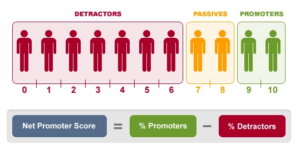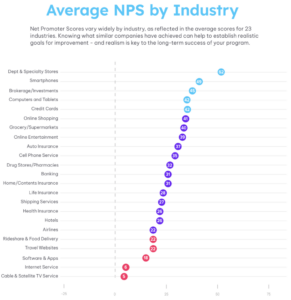Pop Up, Tune In Leverage Popup Surveys to Maximize Engagement
Read More

Net Promoter Score is a standard customer experience metric that enables businesses to gauge their customer retention and loyalty. In simpler terms, the metric measures the willingness of the customers to recommend your brand to their family or friend by asking a simple question –
This question is answered on an 11-point rating scale, ranging from 0 (not at all likely) to 10 (extremely likely). The respondents to these questions are divided into three categories called Promoters, Passives, and Detractors (which we will discuss later) based on their responses.
But is your NPS good or bad?
Let’s get into it.
Deep dive: How is the Net Promoter Score Calculated?
Net Promoter Score Benchmarks by Industry
What is a Good Net Promoter Score?
How to Know If Your Net Promoter Score Is Good?
How to Obtain a Good Net Promoter Score?
To understand whether an NPS score is good or bad, we must first understand how it is calculated.
Before we dive into the specifics of NPS calculation, you must know that NPS is an absolute number that lies between -100 to 100. It is not a percentage as is the case with most KPIs and business metrics.
1. Promoters are customers who have given a score of 9 or 10. You can count on these customers as those with high lifetime value and those who will remain loyal to the business for the foreseeable future.
Also, they are highly likely to act as mouthpieces for word-of-mouth marketing for your business.
2. Passives are customers who have given a score of 7 or 8. They are currently loyal to the brand but are at a high risk of churning. Their loyalty is fickle and hence can be easily lured by competitors with better pricing, features, or even a single negative experience from your business.
3. Detractors are the respondents with a score of 0 to 6. They are a risky lot since instead of spreading positivity about the brand, there is a high chance that they would spread negativity about the brand.
Now that we know what promoters, passives, and detractors are, let’s calculate the NPS Score.

The NPS score is calculated as a difference between % of promoters and detractors.
Let’s take the below example to understand NPS calculation.
In this case, the net promoter score calculation would be
45% (promoters) – 30% (detractors) = 15%
However, our final NPS score would be +15.
As explained before,
NPS is an absolute number and not a percentage. As a result, a ‘%’ will not be appended to the NPS score.
Calculate NPS Score with SurveySensum
That brings us to the question — do NPS scores remain constant from industry to industry?
Are there NPS benchmarks that businesses can measure themselves against? Turns out, yes.
Studies have been conducted to benchmark the NPS scores in each industry.

The average NPS score fluctuates from industry to industry due to customer expectations, service standards, and competition existing in the industry.
For example, the lowest NPS score for Internet Service is 27. Whereas, the highest NPS score for Airlines is 71. If these two scores are compared equally, it will depict a wrong picture of customer loyalty.
Now, this brings us to the big question. What is a good Net promoter score?
As a thumb rule, if the NPS score is less than 0, it is a cause for worry. A positive NPS gives some level of comfort.
In other words, an NPS score above ‘0’ can be considered to be good, anything above ‘50’ is great and anything above ‘70’ is excellent.
However, the law of averages explained before paras apply as well. An NPS score can be considered to be good only if it matches the industry average or exceeds it.
If your NPS score is equal to or more than the industry average, it indicates that your customers are loyal and are willing to refer to new customers as well.
A negative NPS score indicates that there are more customers who would not only refrain from referring new prospects to your business but also might spread negativity.
A positive NPS can be considered good news only if it is above the industry average.
But, the underlying point is, that there are competitors who are doing better than you at winning customer loyalty and new referrals.
In the long run, this could cause your business to lose to the competition. The existing promoters might slip into passives and passive customers could convert into detractors.
So, keeping a tab on your NPS score is crucial. In addition to constant monitoring, you must also check whether the NPS score is good or not.
Launch Your First NPS Survey!
Is your NPS score good or bad? If it is 73, it is surely a good number. But what if your NPS score is 28? Is it bad? Not necessarily. Your NPS score is relative. There are a lot of factors associated with it. This is why benchmarking your NPS score becomes important.
As we said earlier in this blog, NPS is more of an industry-specific metric. So it makes sense to look at the industry average and where your NPS stands in relation to that.
It is also recommended to benchmark your NPS score against that of competitors. This method of relating an NPS score to the industry average and competitor scores is referred to as the relative method of benchmarking.
For example, in the US, the average NPS score of Health Insurance is 48. If your business is in the same line, then your NPS score should ideally be more than 48 or be in this range to be considered a good Net Promoter Score.
If you are a global business, by now it would have been evident how regional differences and cultural values affect consumer decisions.
To cite an example, US customers are willing to pay a premium price for high-end products. Whereas, their Asian counterparts would prefer budget-friendly products that serve the purpose and have reasonable durability.
The same attitude spills over to NPS survey responses as well. The scores that customers give will be largely influenced by regional practices and cultural beliefs.
To repeat the same example of US and Asian customers, US customers are generous when it comes to giving 5-star reviews or high NPS scores. Asian customers expect extremely impressive products/services to give a high NPS score.
As a result, there will be regional imbalances in the NPS score as well. Hence, the need to benchmark NPS and compare it on a regional basis.
Without regional benchmarking, you might end up evaluating an average or Good Net Promoter Score as bad.
NPS surveys are sent through diverse channels like email, social media, mobile apps, SMS, and so on. The survey response is bound to vary due to various factors.
For example, email surveys usually get high responses since customers find them to be non-intrusive in nature. Also, it is easy to fill up an email survey since it gives enough buffer time for the customer to think and update.
Other channels like SMS and in-app surveys lose out on these. However, they have their own pros and cons, which further influence the NPS scores.
In-app surveys are contextual in nature and hence can drive accurate responses, although the response rate could be low.
These differences mean that the business has to populate the NPS score from various channels and compare them side-by-side to arrive at a benchmark score.
Also, take a look at how you can increase your survey response rate with WhatsApp surveys.
NPS is a complex metric that differs from industry to industry based on what services you provide or products you sell. Your NPS score will tell you about all your customers’ negative and positive experiences. Though there are several tips to improve your net promoter score, we list down only the most important ones here.
But to achieve all of these, an efficient NPS tool, designed to evaluate both 11-point and 5-point NPS scales, is required to help you create NPS surveys and launch them at the right touchpoint and at the right time. Also, the tool helps share alerts to the team when a detractor shares their feedback and analyzes all the feedback.
There are several factors you must consider before assuming your NPS score to be good or bad. First of all, it is not a percentage but an absolute value. Secondly, it can vary from industry to industry and from region to region.
The channel through which you got your NPS survey response will also affect the goodness of your NPS score.
There is one motivational quote that is quite popular and has been doing its rounds on the internet for a long time — The only person you should try to be better than is the person you were yesterday.
When it comes to evaluating an NPS score as good or bad, this same quote applies as well. A good Net Promoter Score score is one that is better than your previous NPS score.
NPS score is calculated from -100 to +100. Therefore, any positive value you get is good. To be more specific, any score above 20 is encouraging. The more you get the better it is. (For example, the average NPS score in the financial sector is 35, and ranges up to 60 or above.)
Any positive score is treated as good by some businesses. Whereas, if you take an NPS score of 60, it is excellent and is a very high score in the industry. It means that your customers love your company, and you have a lot of word-of-mouth references.
NPS score is computed from -100 to +100 as an absolute lying number. Therefore, any positive number you get is good. 5 is indeed a good NPS score for businesses. It is worth commenting that you should not stay satisfied with an NPS score of 5, but always push your limits and improve the score.
Apple has an overall net promoter score of 68. It is worth mentioning that Apple sells different product categories, and each of them has an associated NPS score with it. Apple’s top NPS score is 75 for tablets, and the least is 43 for smartphones.
Amazon maintains a pretty good score every year. Amazon is considered one of the best companies in terms of customer loyalty and satisfaction. The NPS score of Amazon is 62 in 2022.
